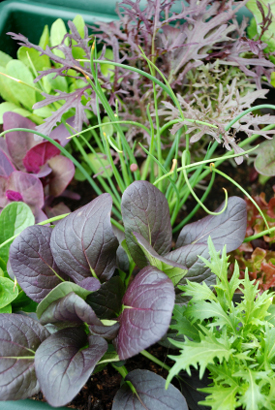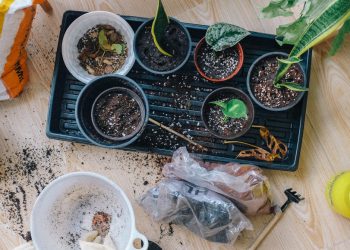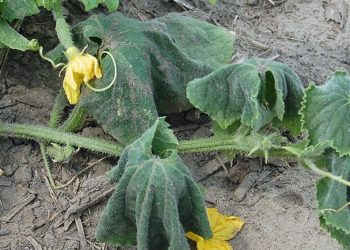 If you are an experienced spring and fall vegetable gardener, you already know what works in your area, and what doesn’t work as well. Of course, personal preference also plays a huge part. (Who’s going to plant vegetables they don’t like?) On the other hand, trying something new is always a good thing! You don’t have to plant a whole row to get a taste for a new variety of an old favorite, or even for something you’ve never put in your mouth before. Planting one or two vegetable plants will do, and then if you like the flavor and it grows well in your area, you can plant it again next year in larger quantities. Don’t be surprised that what comes out of the grocery store will taste bland and uninteresting compared to your homegrown produce.
If you are an experienced spring and fall vegetable gardener, you already know what works in your area, and what doesn’t work as well. Of course, personal preference also plays a huge part. (Who’s going to plant vegetables they don’t like?) On the other hand, trying something new is always a good thing! You don’t have to plant a whole row to get a taste for a new variety of an old favorite, or even for something you’ve never put in your mouth before. Planting one or two vegetable plants will do, and then if you like the flavor and it grows well in your area, you can plant it again next year in larger quantities. Don’t be surprised that what comes out of the grocery store will taste bland and uninteresting compared to your homegrown produce.
If you are new to fall vegetable gardening, you can rely on the advice here and the forthcoming comments from our expert customers who have been there and done that. And you can always ask our Master Gardener if we have failed to answer any of your questions here. That is just one reason we recommend you buy vegetable plants online, from us. We promise a quick and complete answer from a seasoned professional, and every order is backed by our Satisfaction Guarantee!
The first thing to do is to plan. You, of course, will have vegetables you planted in the spring or early summer that are still producing, but there will be many that don’t tolerate the dog days of summer well and will have quit fruiting or growing by mid-July and into August. Pull up all of those that are now just taking up space. Determinate tomatoes and early lettuce will definitely be on this list. Weed well, remove any overgrown plants from these areas, turn the soil, stand back and take stock. Now you know exactly where you have room to plant. You might even want to make yourself a list so that when your plants arrive, you don’t have to try to remember where you wanted to plant what.
You also need to take into consideration your first fall frost date. This information can be found at your local university extension office, online at Plant Maps, or in the Farmer’s Almanac, though unless you are new to an area, you probably already know when the first winter frost usually is. Furthermore, there is a difference between early occurring frost and winter frost. Many of the earlier frosts are very light and of a short duration, which only serve to enhance fall vegetable plant growth; the winter frost is considered the killing frost.
In fact, many of the earlier, light frosts are followed by an Indian summer with warmer than fall-like daytime temperatures and cool fall nighttime temps for a period of two weeks to a month, during which time your fall vegetable garden may explode with growth! So, when researching the fall vegetable plants for sale, count backwards from your first winter frost day, using the days to harvest as a guide, and then plant those fall garden plants that will produce prior to that killer frost. Days to harvest is the period of time from transplant or first mature leafing to the average harvest day, which will also be determined by the weather conditions for any particular year. We try to make gardening an exact science, but Mother Nature keeps us all guessing.
Once you have made your selections, you will also want to order those essential nutrients that you may need to replace. Hopefully you already have a soil tester that will easily determine what you require, but if you don’t, you can search online for what vegetables deplete what nutrients and order those nutrients that will rebuild the soil from the areas that have already been harvested and cleared. You can also order your soil tester at the same time as your fall vegetables and then add supplements as needed. A good rule of thumb is not to plant the same thing in the same place in successive seasons. For example, if you’ve already planted lettuce, do not follow up with another lettuce crop in the same spot. Rotating your crops, as well as repairing or remineralizing your soil by using organic waste products, like compost, are the best methods to provide the essential nutrients that will grow healthy plants, but that will also supply the necessary nutrients to your family.
Now, as far as fall vegetables go, you want to look for the words cool temperatures or cool weather. There are also fall vegetable plants that are classified as tender, semi-tender, semi-hardy and hardy crops. The tender and semi-tender varieties may withstand a first light frost, but will not survive repeated frosts, so plan accordingly. By the same token, the hardy and semi-hardy can often overwinter, depending upon your area, so you may not need to even worry about the days to harvest. As always, this may vary slightly, or a lot, from year to year.
You can look to our Guide to Fall Vegetable Planting for additional information on this topic and for a list of those fall vegetable plants that are categorized as tender, semi-tender, hardy or semi-hardy.
We are always learning, and we strive to provide you, our customers, with the most up-to-date and valuable information available. Please feel free to comment at any time.
Happy Fall Gardening and Harvesting!





No Comments